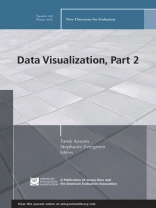This issue delivers concrete suggestions for optimally using data visualization in evaluation, as well as suggestions for best practices in data visualization design. It focuses on specific quantitative and qualitative data visualization approaches that include data dashboards, graphic recording, and geographic information systems (GIS).
Readers will get a step-by-step process for designing an effective data dashboard system for programs and organizations, and various suggestions to improve their utility. The next section illustrates the role that graphic recording can play in helping programs and evaluators understand and communicate the mission and impact that an intervention is having in a democratic and culturally competent way. The GIS section provides specific examples of how mapped data can be used to understand program implementation and effectiveness, and the influence that the environment has on these outcomes.
* Discusses best practices that inform and shape our data visualization design choices
* Highlights the best use of each tool/approach
* Provides suggestions for effective practice
* Discuss the strengths and limitations of each approach in evaluation practice
This is the 140th volume of the Jossey-Bass quarterly report series New Directions for Evaluation, an official publication of the American Evaluation Association.
表中的内容
EDITOR-IN-CHIEF’S COMMENT 1
Paul R. Brandon
EDITORS’ NOTES 3
Tarek Azzam, Stephanie Evergreen
5. Design Principles for Data Visualization in Evaluation5
Stephanie Evergreen, Chris Metzner
This chapter will present design principles that contribute toachieving the communication goal of data visualization, which is tograb audience attention and help them engage with the data suchthat the resulting
product is increased understanding.
6. Data Dashboard as Evaluation and Research Communication Tool 21
Veronica S. Smith
This chapter introduces evaluators to data dashboards, which arevisual displays that feature the most important information neededto achieve specific goals captured on a single screen. This chapterwill
highlight keys to realizing the potential of data dashboards bydescribing appropriate use and effective practices for designingand creating these tools.
7. Graphic Recording 47
Jara Dean-Coffey
This chapter explores graphic recording, which is a visualizationprocess that captures the themes and ideas emerging from groupdiscussions.The chapter provides information on what the graphicrecording process can look like and how it can fit into evaluationpractice.
8. Mapping Data, Geographic Information Systems 69
Tarek Azzam
This chapter offers an introduction to geographic informationsystems (GIS) and provides examples of how this approach to datavisualization can help evaluators better understand the context inwhich they
are working, conduct a deeper analysis of the data, and communicateusing maps to illustrate important findings and patterns.
INDEX 8
关于作者
Tarek Azzam is the editor of Data Visualization, Part 2: New Directions for Evaluation, Number 140, published by Wiley. Stephanie Evergreen is the editor of Data Visualization, Part 2: New Directions for Evaluation, Number 140, published by Wiley.












